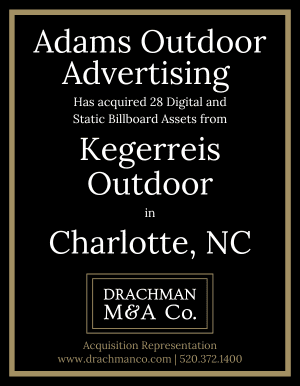Billboard Insider was founded on the idea that we learn from each other. To that end, we we are starting an interview series where senior out of home execs talk about issues impacting the out of home business. Today Clear Channel Outdoor’s Wade Rifkin talks about programmatic out of home.

Wade Rifkin is senior vice president of programmatic for Clear Channel Outdoor Americas. He came to CCOA about a year ago and is responsible for developing new ways to make CCOA’s media inventory available for programmatic buying and establishing partnerships within the ad tech space to facilitate programmatic transaction.
Wade joined CCOA from ShareThis, where he was responsible for identifying new opportunities to bring the ShareThis data set to market through business development across the programmatic landscape. Before ShareThis, he was vice-president of programmatic at DigitasLBi where he established their Programmatic practice across the U.S. He was also vice-president and group media director for Digitas where he led two digital media teams and directed various American Express-branded initiatives.
Previously in his career, Wade held positions at Wieden + Kennedy and Zenith Media.
Wade, could you share with us some highlights from your first year as Senior VP of Programmatic at Clear Channel Outdoor?
Absolutely – my first year was about learning what programmatic OOH meant to our clients, applying that learning to create a meaningful solution for our buyers and then integrating that offering into our broader product portfolio. Specifically:
We conducted market research to better understand the needs of our existing OOH buyers, as well as prospective programmatic buyers, and conceptualize a solution that delivered on their collective needs. That pointed us to a biddable, marketplace solution for our digital roadside & airport inventory that can be tapped into by cross-channel DSPs.
We partnered with Rubicon Project and deployed a first-to-market private marketplace solution for our digital inventory, creating the blueprint for DSP-based, real time biddable OOH transaction. This allows our clients to buy digital OOH like display, in true programmatic fashion, lending the reach & impact for which our media channel is historically known.
We brought our programmatic and Clear Channel Outdoor RADAR solutions together, enabling data-driven targeting and attribution for programmatic DOOH campaigns. Even more exciting, this data can now be applied holistically, across our direct + programmatic, digital and printed assets for a truly unified media + measurement approach from CCO.
One of your key tasks has been to develop strategic partnerships with data providers and ad technology companies. How much progress have you made and what do you think it is that CCO brings to the table that can attract those key relationships?
We’ve been able to make significant headway on the partnership front, and from a programmatic perspective, we now work with two Supply Side Platforms (SSPs) and seven different Demand Side Platforms (DSPs). Our position as one of the market leaders in both roadside and airport inventory scale has been a big driver in getting traction with DSPs, but equally important is the demand that the platforms are seeing from our shared clients. The combination of the demand side interest and the supply-side reach & impact continues to resonate with our growing roster of best in class ad tech platforms.
How is OOH perceived in general by the non-OOH companies and brands in the programmatic world?
 Two perceptions that have surfaced from time to time are that OOH is disconnected from other channels and is unmeasurable. I’m happy to say that we’ve been able to address both; OOH is now accessible programmatically through the same platforms being used to buy display, video, mobile and other channels, helping to power a more omnichannel programmatic media mix. Everything we’re doing with CCO RADAR offers more data & more accountability than was previously available in OOH.
Two perceptions that have surfaced from time to time are that OOH is disconnected from other channels and is unmeasurable. I’m happy to say that we’ve been able to address both; OOH is now accessible programmatically through the same platforms being used to buy display, video, mobile and other channels, helping to power a more omnichannel programmatic media mix. Everything we’re doing with CCO RADAR offers more data & more accountability than was previously available in OOH.
Both of these facts have been surprising and delighting buyers, and we’re constantly walking out of meetings with folks saying that they had no idea OOH had progressed as far as it has, and didn’t know that these new targeting, optimization or measurement use cases were even possible, let alone as developed as they are.
Scott Wells talks about the importance of speed of innovation for CCO and OOH as a whole. How has your programmatic group assisted in that goal and how much of that depends on communication and coordination with your peers in technology, marketing and sales?
Our iterative approach has allowed us to build our solution and go to market quickly – we were live with an alpha version of our offering 8 months after I joined CCO. That required a tight-knit working approach with internal folks in tech, inventory management & ad ops, as well as counterparts at Rubicon Project, and DSPs that were willing to be the first over the wall to test. As we’ve scaled the business, it has certainly required close collaboration with our broader sales organization, ensuring that we use the two discrete, but complementary ways to transact our inventory in a holistic way to deliver on client KPIs.
This PMP solution also creates an opportunity for our agency partners in particular – it’s a reason for two previously independent groups – OOH buyers and programmatic buyers – to come together to figure out an activation model to bring it to life. It also gives them a new offering to merchandise to their clients, with a new set of meaningful capabilities to unlock through a highly scalable digital channel.
If you’d like to be featured in a management perspectives column contact Insider using the form below.
[wpforms id=”8663″]
Paid Advertisement















